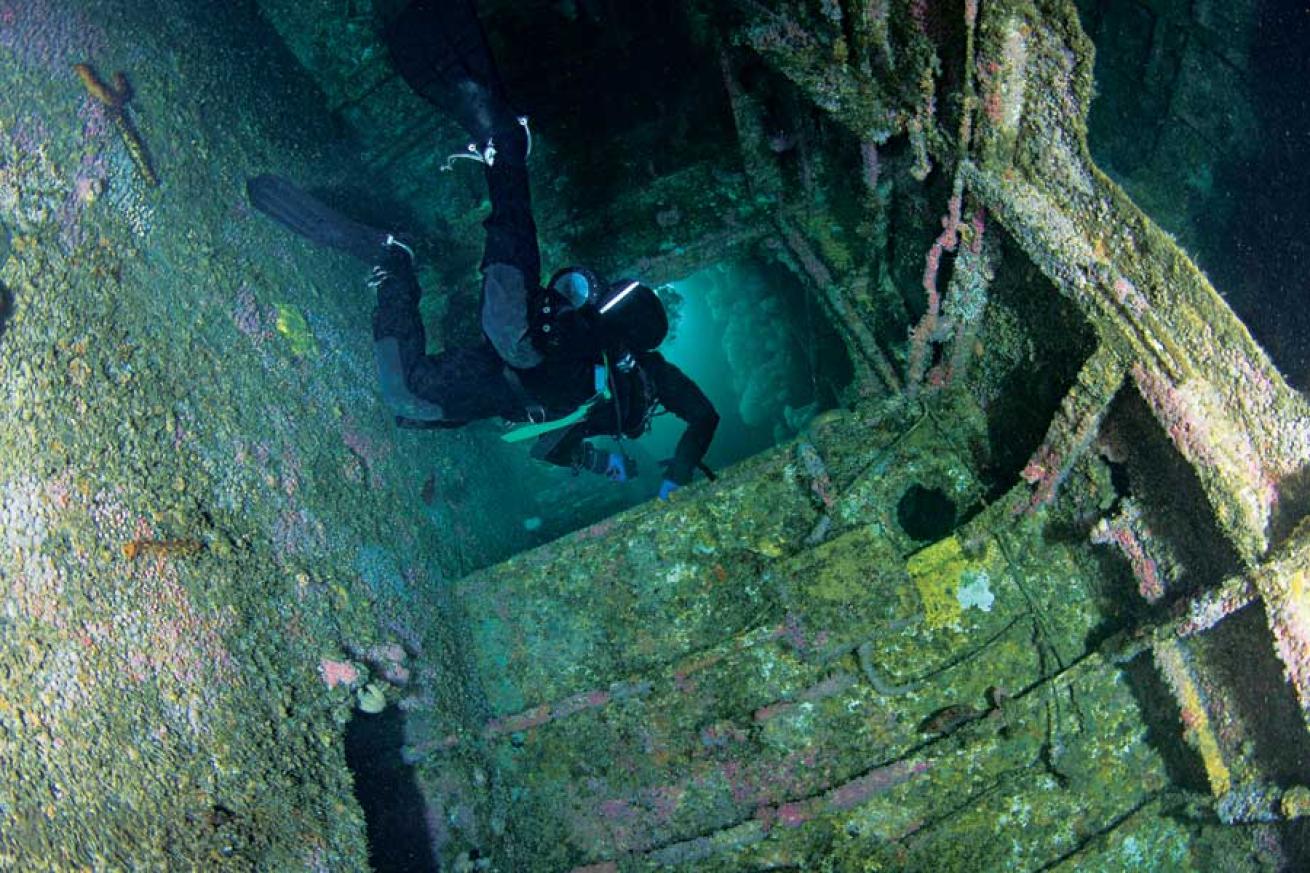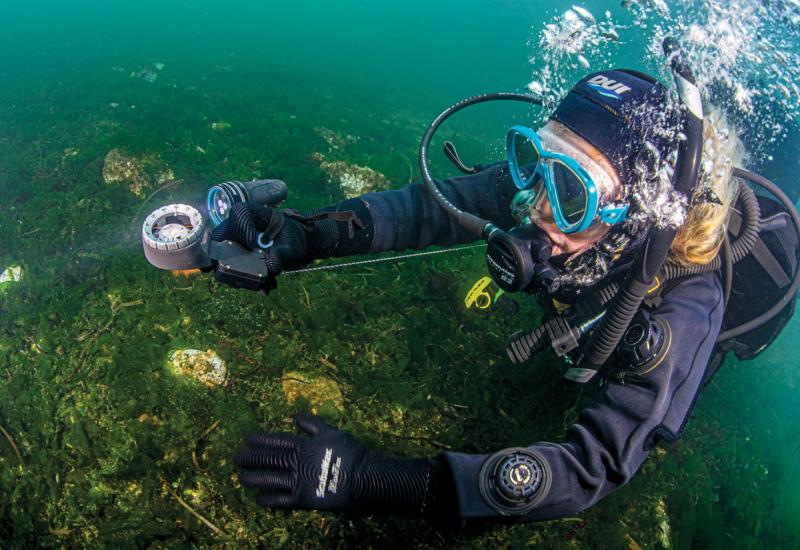Ask an Expert: Should You Ever Enter a Wreck Without Training?

Entering an Underwater Wreck
Should you ever enter a wreck without special dive training?
Ashley Hauck
Every year, divers get in trouble when they venture under the ice or into caves unprepared for potential problems (see the latest Lessons for Life). In these situations, a dive can’t simply be aborted with a normal ascent to the surface. But what about shipwrecks? Is it really a problem to swim inside the pilothouse of a wreck to get a photo of yourself looking out through a porthole?
It depends.
There are some intentionally sunk artificial reefs that have been prepared for divers with no special equipment or training for basic penetration. There are others that went down in a more traditional sense that are dark, dangerous and deadly.
No, all wreck diving requires training.
“I’ve taken thousands of people out to intentionally sunk shipwrecks, and thousands of them did penetrations of some of the above-deck passages. Hundreds did advanced technical penetrations of major parts of the interiors. My skin crawled every time. With alarming frequency, out-of-air emergencies and narcosis-panic dense-air trouble occurs on these wreck dives. The number of near misses is astonishing.
“Overhead environments should first be experienced while under the guidance of an instructor. Understanding recreational limits in places like wrecks should not be listed under ‘things I learned the hard way.’ Buy the book. Read it. Pay the instructor. Only bad things happen quickly.” — Bob Bates, dive instructor and commercial-boat captain
Yes, but under specific conditions.
“If you are competent and the wreck is intentionally sunk with openings everywhere, it is a safe endeavor. The Yukon in San Diego is a great example. On a good day, light penetration is perfectly safe, even for relatively new divers. You should do it with the utmost care and with (at a minimum) someone experienced in wreck diving, and that wreck in particular. There just aren’t that many fatalities in intentionally sunk wrecks, and there are thousands of divers in them without the card.” — Brian Netzel, divemaster and technical diver
“Beginner wrecks where there’s direct access to the surface from some interior areas, I think that is fine. Missing deckplates and open cargo hatches make it reasonably easy to go inside the skin of the ship, though they still tell you not to go down into the cargo holds. Wreck penetration where there’s an overhead environment is an entirely different thing. That most definitely requires specialized training.” — Eric Hexdall, retired U.S. Navy salvage diver who is now the clinical director of Duke Dive Medicine
Conclusion
There are always degrees of risk with diving. Divemaster Marie Sharp noted: “Any well-trained diver understands that every dive is a risk. With acceptable diving conditions, and with briefing and guidance by a certified, insured instructor, a well-controlled swim-through into a wreck designed for divers with two or more visible outside openings can be OK.”
Most dive leaders accept that penetrating a shipwreck set up to be penetrated is probably all right under good conditions. Venturing beyond those prepared areas, or assuming that experience in one artificial reef means you can penetrate any shipwreck, is a recipe for disaster.
Shipwrecks come with great mystery and excitement. They can draw divers to go just a little bit farther, or to look into one more room. It’s easy to become disoriented inside a ship that’s lying on its side, or to lose the way out when you stir up silt. While accidents where divers get lost in shipwrecks are rare, they do happen. Divers can get in trouble when they attempt to push their limits without understanding what those limits are.
More Expert Advice:
Are Rebreathers Really Recreational? | Should Divers Reveal Their Medications? | Is it OK to Touch a Shark?

Ashley HauckShould you ever enter a wreck without special dive training?
Every year, divers get in trouble when they venture under the ice or into caves unprepared for potential problems (see Lessons for Life). In these situations, a dive can’t simply be aborted with a normal ascent to the surface. But what about shipwrecks? Is it really a problem to swim inside the pilothouse of a wreck to get a photo of yourself looking out through a porthole?
It depends.
There are some intentionally sunk artificial reefs that have been prepared for divers with no special equipment or training for basic penetration. There are others that went down in a more traditional sense that are dark, dangerous and deadly.
No, all wreck diving requires training.
“I’ve taken thousands of people out to intentionally sunk shipwrecks, and thousands of them did penetrations of some of the above-deck passages. Hundreds did advanced technical penetrations of major parts of the interiors. My skin crawled every time. With alarming frequency, out-of-air emergencies and narcosis-panic dense-air trouble occurs on these wreck dives. The number of near misses is astonishing.
“Overhead environments should first be experienced while under the guidance of an instructor. Understanding recreational limits in places like wrecks should not be listed under ‘things I learned the hard way.’ Buy the book. Read it. Pay the instructor. Only bad things happen quickly.” — Bob Bates, dive instructor and commercial-boat captain
Yes, but under specific conditions.
“If you are competent and the wreck is intentionally sunk with openings everywhere, it is a safe endeavor. The Yukon in San Diego is a great example. On a good day, light penetration is perfectly safe, even for relatively new divers. You should do it with the utmost care and with (at a minimum) someone experienced in wreck diving, and that wreck in particular. There just aren’t that many fatalities in intentionally sunk wrecks, and there are thousands of divers in them without the card.” — Brian Netzel, divemaster and technical diver
“Beginner wrecks where there’s direct access to the surface from some interior areas, I think that is fine. Missing deckplates and open cargo hatches make it reasonably easy to go inside the skin of the ship, though they still tell you not to go down into the cargo holds. Wreck penetration where there’s an overhead environment is an entirely different thing. That most definitely requires specialized training.” — Eric Hexdall, retired U.S. Navy salvage diver
Conclusion
There are always degrees of risk with diving. Divemaster Marie Sharp noted: “Any well-trained diver understands that every dive is a risk. With acceptable diving conditions, and with briefing and guidance by a certified, insured instructor, a well-controlled swim-through into a wreck designed for divers with two or more visible outside openings can be OK.”
Most dive leaders accept that penetrating a shipwreck set up to be penetrated is probably all right under good conditions. Venturing beyond those prepared areas, or assuming that experience in one artificial reef means you can penetrate any shipwreck, is a recipe for disaster.
Shipwrecks come with great mystery and excitement. They can draw divers to go just a little bit farther, or to look into one more room. It’s easy to become disoriented inside a ship that’s lying on its side, or to lose the way out when you stir up silt. While accidents where divers get lost in shipwrecks are rare, they do happen. Divers can get in trouble when they attempt to push their limits without understanding what those limits are.
More Expert Advice:
Are Rebreathers Really Recreational? | Should Divers Reveal Their Medications? | Is it OK to Touch a Shark?










